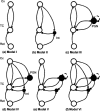Reciprocal inhibition and slow calcium decay in perigeniculate interneurons explain changes of spontaneous firing of thalamic cells caused by cortical inactivation
- PMID: 23150147
- PMCID: PMC3650241
- DOI: 10.1007/s10827-012-0430-8
Reciprocal inhibition and slow calcium decay in perigeniculate interneurons explain changes of spontaneous firing of thalamic cells caused by cortical inactivation
Abstract
The role of cortical feedback in the thalamocortical processing loop has been extensively investigated over the last decades. With an exception of several cases, these searches focused on the cortical feedback exerted onto thalamo-cortical relay (TC) cells of the dorsal lateral geniculate nucleus (LGN). In a previous, physiological study, we showed in the cat visual system that cessation of cortical input, despite decrease of spontaneous activity of TC cells, increased spontaneous firing of their recurrent inhibitory interneurons located in the perigeniculate nucleus (PGN). To identify mechanisms underlying such functional changes we conducted a modeling study in NEURON on several networks of point neurons with varied model parameters, such as membrane properties, synaptic weights and axonal delays. We considered six network topologies of the retino-geniculo-cortical system. All models were robust against changes of axonal delays except for the delay between the LGN feed-forward interneuron and the TC cell. The best representation of physiological results was obtained with models containing reciprocally connected PGN cells driven by the cortex and with relatively slow decay of intracellular calcium. This strongly indicates that the thalamic reticular nucleus plays an essential role in the cortical influence over thalamo-cortical relay cells while the thalamic feed-forward interneurons are not essential in this process. Further, we suggest that the dependence of the activity of PGN cells on the rate of calcium removal can be one of the key factors determining individual cell response to elimination of cortical input.
Figures







Similar articles
-
A multivariate population density model of the dLGN/PGN relay.J Comput Neurosci. 2006 Oct;21(2):171-89. doi: 10.1007/s10827-006-7753-2. Epub 2006 Jun 12. J Comput Neurosci. 2006. PMID: 16788765
-
Synaptic properties of the feedback connections from the thalamic reticular nucleus to the dorsal lateral geniculate nucleus.J Neurophysiol. 2020 Aug 1;124(2):404-417. doi: 10.1152/jn.00757.2019. Epub 2020 Jul 1. J Neurophysiol. 2020. PMID: 32609582 Free PMC article.
-
Organization of visual inputs to interneurons of lateral geniculate nucleus of the cat.J Neurophysiol. 1977 Mar;40(2):410-27. doi: 10.1152/jn.1977.40.2.410. J Neurophysiol. 1977. PMID: 191574
-
The control of retinogeniculate transmission in the mammalian lateral geniculate nucleus.Exp Brain Res. 1986;63(1):1-20. doi: 10.1007/BF00235642. Exp Brain Res. 1986. PMID: 3015651 Review.
-
Thalamic relays and cortical functioning.Prog Brain Res. 2005;149:107-26. doi: 10.1016/S0079-6123(05)49009-3. Prog Brain Res. 2005. PMID: 16226580 Review.
Cited by
-
Biophysical network modeling of the dLGN circuit: Effects of cortical feedback on spatial response properties of relay cells.PLoS Comput Biol. 2018 Jan 29;14(1):e1005930. doi: 10.1371/journal.pcbi.1005930. eCollection 2018 Jan. PLoS Comput Biol. 2018. PMID: 29377888 Free PMC article.
-
Information-theoretic analyses of neural data to minimize the effect of researchers' assumptions in predictive coding studies.PLoS Comput Biol. 2023 Nov 17;19(11):e1011567. doi: 10.1371/journal.pcbi.1011567. eCollection 2023 Nov. PLoS Comput Biol. 2023. PMID: 37976328 Free PMC article.
-
Signal Propagation via Open-Loop Intrathalamic Architectures: A Computational Model.eNeuro. 2020 Feb 25;7(1):ENEURO.0441-19.2020. doi: 10.1523/ENEURO.0441-19.2020. Print 2020 Jan/Feb. eNeuro. 2020. PMID: 32005750 Free PMC article.
References
Publication types
MeSH terms
Substances
LinkOut - more resources
Full Text Sources
Miscellaneous

